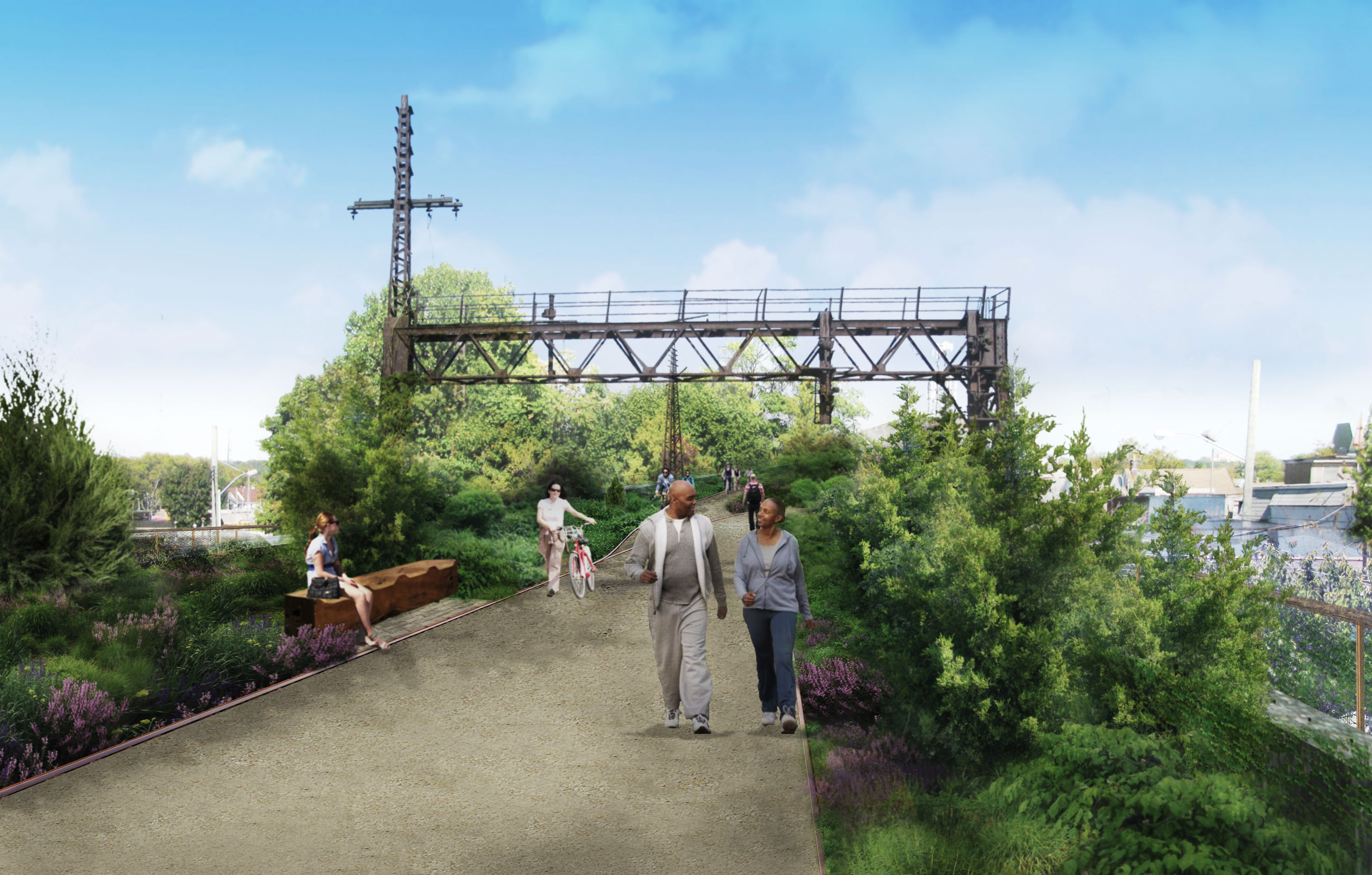
Some folks stroll along the virtual QueensWay. (Rendering via WXY architecture + urban design and DLANDStudio Architecture & Landscape Architecture)
Thanks for bearing with me over the last few days. I’ve started a new job, and time was at a premium earlier this week. I’ve missed some big news though as someone smoke-bombed Bar Pitti by popping out of an emergency access grate just south of the West 4th St. subway station and Transit Wireless is set to unveil subway cell service at nearly 30 stations in Queens. I’ll cover that in due time, but tonight, we talk about the QueensWay.
Earlier this week, the folks behind the QueensWay — some CB heads in Queens, the Trust for Public Land, formers Parks Department head Adrian Benepe — unveiled a snazzy new website and the results of their state-funded study regarding the proposal to turn the defunct Rockaway Beach Branch right-of-way into a 3.5-mile park. They’ve designed something that they keep referring to as the High Line of Queens. It will supposedly have space for ample pedestrian pathways and a two-way bike lane; it will cost at least $125 million; and around 1 million people per year — 250,000 from outside of the area — will visit.
In a vacuum, it’s not a terrible idea. The costs are high; for only $25 million less than what it cost to build two phases of the High Line, the QueensWay would draw in around 3 million fewer visitors per year. But the renderings sure are nice, and Queens needs the to improve alternate transportation modes on a route that parallels Woodhaven Boulevard. But planning doesn’t exist in a vacuum. I’d rather see the city reimagine Woodhaven itself, and the RBBL ROW offers the city a unique opportunity to take advantage of a rail ROW through a neighborhood that badly needs high-speed transit connections. (Just look at the completely unironic Subway Links section of the website.) Unfortunately, no one as powerful as the Trust for Public Land or Benepe, let alone Gov. Cuomo who funded the latest round of renderings, is backing rail reactivation.
Over the past few days, a lot of voices have come out against the QueensWay plan. Assembly member Phil Goldfeder, one of the few politicians skeptical of the park, released his own statement:
The Queensway and Trust for Public Land have wasted taxpayer dollars on expensive, out of state consultants and one-sided studies that don’t actually represent the interests or needs of Queens families. Elected officials and community leaders from every part of the borough and as far as Manhattan have expressed full support for the complete restoration of the Rockaway Beach Rail Line and increased transit options.
In a few weeks, the Queens College Department of Urban Studies will release its own comprehensive and objective study, done by local scholars, faculty and students. I am confident that this new independent study will reflect the true needs of Queens residents and small businesses. Our growing coalition, including the MTA, will continue the fight to expand transit in Queens while easing commutes, creating jobs, cleaning the environment and expanding our economic development.
Gothamist too issued a takedown of the Queensway, echoing arguments I’ve made in the past. To me, though, there are two distinct problems with QueensWay. The first is that the people in the area and those arguing for it don’t really want it. Everyone keeps calling it the High Line of Queens as though that’s a net positive, but a non-insignificant portion of Manhattanites feel that the High Line isn’t what they wanted New York to become. It’s become a tourist trap and a high-end condo trap. Long-time residents and business have become priced out of what has become a very exclusive neighborhood. Even as I stray into NIMBY territory, divorce yourself from that Manhattan experience, and imagine it in Queens. It just wouldn’t fly.
But worse is the way this area needs rail. The MTA vaguely committed to RBBL reactivation in its 20-year needs assessment, but the project has no fiscal champion. As we’ve learned, if someone delivers money, the MTA will deliver a project. If the RBBL becomes a park, no matter how much we spend on that park, it will never be rail. When or if an impartial study says rail reactivation is a definite impossibility that no one would use, we can turn it over to the QueensWay. For now, though, this artery preserved for rail from the Rockaways to Queens Boulevard is too important to give up. It’s a shame that advocates who are usually on the same side have wound up fighting each other over this plan, but the choices we make now with regards to this 3.5-mile ROW will reverberate for decades.
















 Franklin Av Shuttle
Franklin Av Shuttle A few years ago, at around the time Sandy swept through New York, Andrew Cuomo determined it looked gubernatorial and in charge for him to announce good news regarding the MTA. In the grand tradition of New York executives stretching back to 1968, Cuomo decided that the MTA could be used to boost his image with downstate voters, and now, every time good news comes out, his press office sends out an email “announcing” the happenings. Tunnels reopening? Sandy work on the R train wrapping early? New wireless service underground? Federal storm preparedness funds? It all comes from Cuomo’s office.
A few years ago, at around the time Sandy swept through New York, Andrew Cuomo determined it looked gubernatorial and in charge for him to announce good news regarding the MTA. In the grand tradition of New York executives stretching back to 1968, Cuomo decided that the MTA could be used to boost his image with downstate voters, and now, every time good news comes out, his press office sends out an email “announcing” the happenings. Tunnels reopening? Sandy work on the R train wrapping early? New wireless service underground? Federal storm preparedness funds? It all comes from Cuomo’s office.
